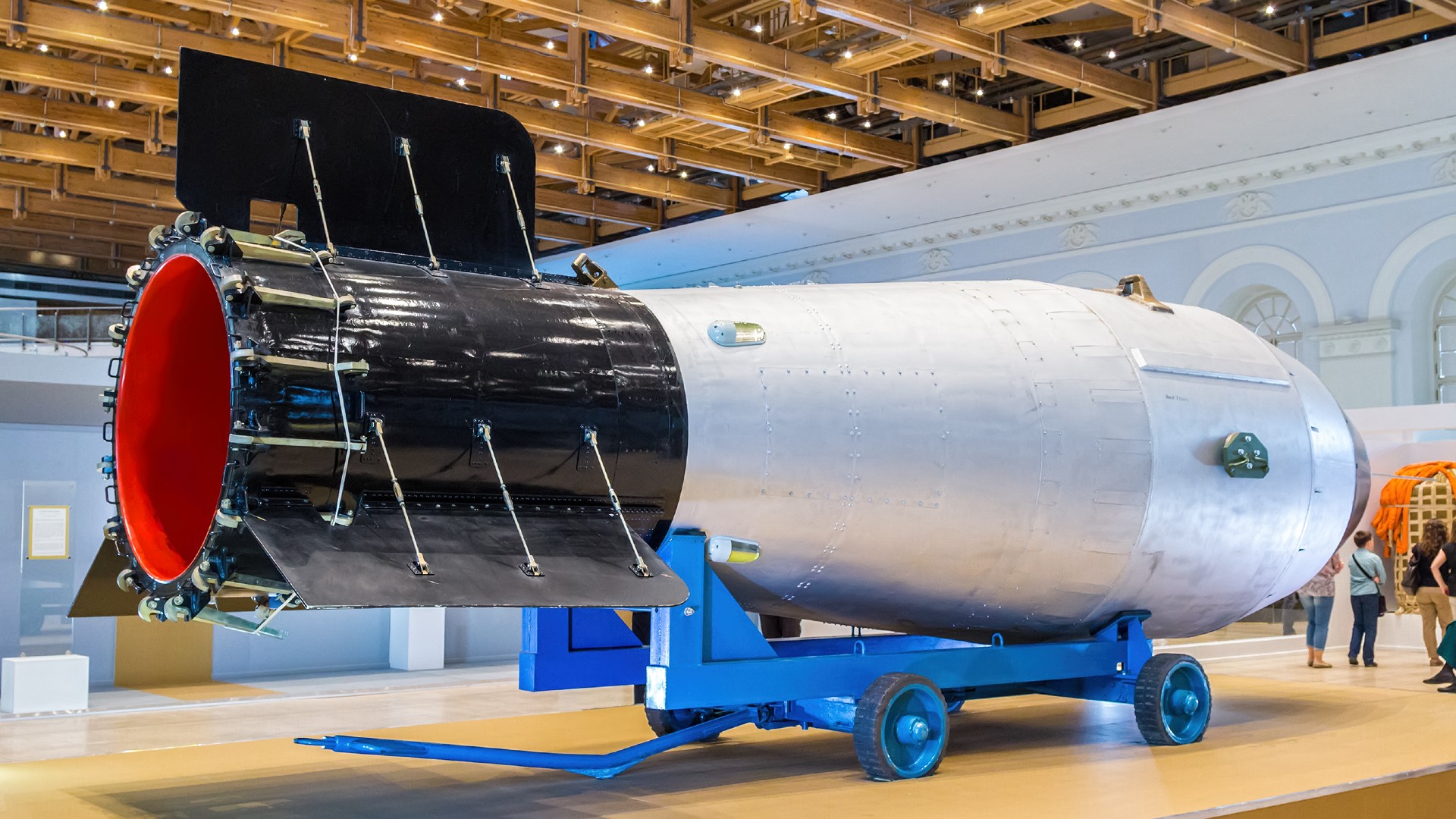How many nuclear weapons exist?
And who has them?

Since Russia first invaded Ukraine nearly three weeks ago, the threat of nuclear weapon use has risen.
This was made clear on Feb. 27, when Russian President Vladimir Putin announced that his country's nuclear forces had been placed on "high alert," the Associated Press reported. The current situation, according to the Bulletin of the Atomic Scientists, is a "nightmare scenario" brought to life.
So, when Putin said his country's nuclear weapons were on high alert, what did he mean? Also, how many nuclear weapons exist, who has them, and how powerful are they?
Nuclear weapons analysts estimate that the world's nine nuclear states — China, France, India, Israel, North Korea, Pakistan, Russia, the United Kingdom and the United States — have around 13,000 nuclear warheads in total, according to the Arms Control Association. However, this estimate is based only on publicly available information; there could be many more that states have not disclosed.
"We know which countries have nuclear weapons, but we don't necessarily know how many nuclear weapons they have; Israel, for instance, does not publicly acknowledge its program," Anne Harrington, a senior lecturer in international relations at Cardiff University in the U.K., told Live Science. "The number of nuclear weapons China has is also a major subject of debate."
How many nuclear weapons are out there?
Since the end of the Cold War, both the U.S. and Russia have reduced their respective nuclear arsenals, and their nuclear stockpiles are far smaller than they were at their height. In 1967, the United States had 31,225 nuclear weapons, Homeland Security Newswire reported. At the time of the Soviet Union's collapse in 1991, around "35,000 nuclear weapons remained at thousands of sites across a vast Eurasian landmass that stretched across eleven time zones," according to a Harvard Kennedy School report written by Graham Allison, a national security analyst at the school.
Today, Russia says it has 6,257 nuclear warheads, while the United States admits to having 5,550, according to a January fact sheet released by the Arms Control Association. However, this drastic reduction is "mainly due to them dismantling retired warheads," Sara Medi Jones, a campaigner at the Campaign for Nuclear Disarmament (CND), told Live Science..
Get the world’s most fascinating discoveries delivered straight to your inbox.
In fact, "there was actually an increase in deployed warheads last year [2021], and all nine nuclear-armed states are either upgrading or increasing their arsenals," Jones said.
"Although it's difficult to know definitively exactly how nuclear arsenals are changing, we assess that China, India, North Korea, Pakistan and the United Kingdom, as well as possibly Russia, are all increasing the number of nuclear weapons in their military stockpiles," said Matt Korda, a senior research associate and project manager for the Nuclear Information Project at the Federation of American Scientists.
Related: The 9 most powerful nuclear explosions
How quickly can nuclear weapons be deployed?
As for how quickly a nuclear weapon could be deployed and how many are on "high alert," there is "a bit of a spectrum," Korda told Live Science. The U.S. and Russia keep a portion of their nuclear weapons on prompt alert, meaning they could be ready to launch "in under 15 minutes," he said. A 2015 paper by the Union of Concerned Scientists estimated that the U.S. and Russia each had around 900 weapons on such hair-trigger alert.
Other countries — including China, Israel, India and Pakistan — keep their nuclear weapons in central storage, meaning they would have to be taken out and "mated to their delivery systems in a crisis," Korda said. This could take days, or even weeks, to arrange.
And others, such as the United Kingdom, have nuclear weapons "deployed at all times on ballistic missile submarines," but these are kept in detargeted mode and would require "hours or days to be brought to launch-ready status," Korda said.
How powerful are the nuclear weapons out there?
Nuclear weapons vary in their destructive power. In the United States' current nuclear arsenal, the most powerful bomb is the B83, which has a maximum yield of 1.2 megatons, making it 60 times more powerful than the bomb dropped on Nagasaki, Japan, in 1945. According to the Nuclear Weapon Archive, 650 B83s are in "active service."
However, the destructive capability of the B83 pales in comparison with the most powerful bomb ever made: the Soviet Union's "Tsar Bomba," which had a yield of 50 megatons — around 2,500 times more powerful than the weapon that destroyed Nagasaki. The Tsar Bomba was a one-off designed to showcase the Soviet Union's military might, and to date, no further iterations of the weapon have been made.
Hydrogen bombs, such as the B83 or Tsar Bomba, utilize nuclear fusion, whereas atomic bombs rely on fission. In terms of destructive capacity, there is no comparison: Hydrogen bombs have the "potential to be 1,000 times more powerful than an atomic bomb," according to a Time magazine article reprinted with by the Harry S. Truman Library and Museum.
Another key distinction is whether a nuclear weapon is categorized as "strategic" or "nonstrategic," Korda said.
Strategic weapons can "reach from Moscow to Washington, D.C., while nonstrategic, tactical nuclear weapons have shorter ranges," said Samuel Hickey, a research analyst at the nonprofit Center for Arms Control and Non-Proliferation.
"On the surface, it seems logical to assume that 'nonstrategic' weapons have lower yields and that 'strategic' weapons have higher yields," Korda said in an email. That's usually, but not always, the case.
And even "low-yield" weapons have the capacity to be incredibly destructive. The United States' new "low-yield" W76-2 submarine-based warhead, proposed and developed under the Trump administration, has a yield of approximately 5 kilotons. In comparison, the "Fat Man" bomb that the U.S. dropped on Nagasaki had a blast yield of 21 kilotons and is estimated to have instantly killed around 40,000 people. Many thousands more died as a result of long-term health effects, such as leukemia, directly attributed to the bomb.
"There is no way to use one [nuclear weapon] without escalating a crisis and murdering civilians," Hickey told Live Science. "Just this past January, the leaders of China, France, Russia, the United Kingdom and the United States together affirmed that 'a nuclear war cannot be won and must never be fought,'" as the consequences of a single weapon detonation would be catastrophic."
How are nuclear weapons stored?
While each country has its own specific storage system, storage facilities are generally blast-resistant and are often buried underground to "limit the damage of an accidental detonation and to protect from an attack," Hickey said.
In the United States, nuclear weapons are "kept under cryptographic combination lock to prevent unauthorized use," Hickey said. In theory, only the president has the authority to sanction their use, but according to Hickey, "if the cryptographic code is input or bypassed, the nuclear weapons could be armed in a matter of minutes." However, Hickey also confirmed that these weapons would need to be "affixed to a missile or deployed on an aircraft" in order to be launched.
Given that the launch of a nuclear weapon would, in all likelihood, be met with immediate retaliation and could lead to all-out global nuclear war, is there a chance that all nuclear weapons could be decommissioned for the greater good? Could there ever be a future without nuclear weapons?
"I don't think this is going to happen," said Holger Nehring, chair in contemporary European history at the University of Stirling in Scotland. "Nuclear weapons are mainly a form of deterrence against nuclear attack, so states have no real interest in getting rid of them. Entirely getting rid of nuclear weapons would mean a very high level of trust between all states in the international system, and this is unlikely to be achieved."
Andrew Futter, a professor of international politics at the University of Leicester in England, agreed. "We have probably reached a point now where further big reductions are unlikely," he told Live Science.
Originally published on Live Science.

Joe Phelan is a journalist based in London. His work has appeared in VICE, National Geographic, World Soccer and The Blizzard, and has been a guest on Times Radio. He is drawn to the weird, wonderful and under examined, as well as anything related to life in the Arctic Circle. He holds a bachelor's degree in journalism from the University of Chester.
